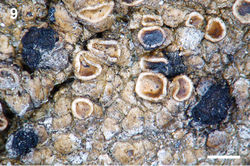Phacographa protoparmeliae
| Notice: | This page is derived from the original publication listed below, whose author(s) should always be credited. Further contributors may edit and improve the content of this page and, consequently, need to be credited as well (see page history). Any assessment of factual correctness requires a careful review of the original article as well as of subsequent contributions.
If you are uncertain whether your planned contribution is correct or not, we suggest that you use the associated discussion page instead of editing the page directly. This page should be cited as follows (rationale):
Citation formats to copy and paste
BibTeX: @article{Westberg2015MycoKeys, RIS/ Endnote: TY - JOUR Wikipedia/ Citizendium: <ref name="Westberg2015MycoKeys">{{Citation See also the citation download page at the journal. |
Ordo: Arthoniales
Familia: Roccellaceae
Genus: Phacographa
Name
Phacographa protoparmeliae Hafellner, 2009 – Wikispecies link – Pensoft Profile
- Phacographa protoparmeliae Hafellner. Bibl. Lich. 100: 106. 2009.
Holotype
AUSTRIA, Kärnten: Hohe Tauern, Kreuzeck-Gruppe, Kalkschieferwände in den SE-Hängen der Sensenspitze N der Turgger Alm, c. 200 m. 17 July 1978, Hafellner 603 (GZU).
Distribution
New to the Nordic countries. Phacographa was described by Hafellner 2009[1] who included three species in the genus. It belongs in the newly described family Lecanographaceae within the Arthoniales (Frisch et al. 2014[2]). Phacographa protoparmeliae (Fig. 9) was originally reported from Austria and Spain (Hafellner 2009[1]), and a specimen was later discovered in the Murmansk region in arctic Russia (Fryday 2011[3]). Here we report it for the first time from the Nordic countries from two localities in Norway. Both are at old copper mines in subalpine habitats in the mining district of Røros in central Norway. Phacographa protoparmeliae (Fig. 9) is a lichenicolous fungus growing on the common and widespread saxicolous lichen Protoparmelia badia. The apothecia of Phacographa have a black margin around a dark brown disc; they are up to 1.2 mm wide in the Norwegian material and form clustered groups of 2–6 apothecia. Microscopically it is characterized by its 3-septate, spores, 22–25 × 6–7(–8) µm that are colourless but have a perispore sheath that becomes brown with age. More detailed descriptions can be found in Hafellner (2009)[1] and Fryday (2011)[3].
Specimens examined
NORWAY. Sør-Trøndelag: Røros, Storwartz, at the site of the old copper-mine, 62°37.63'N, 11°31.19'E. 15 June 2012, Westberg 12-030 (S F265199); Røros, Klasberget, old copper mine NE of farm Svensvollen, 62°39.25'N, 11°34.06'E. 16 June 2012, Westberg 12-052 (S F265200).
Taxon Treatment
- Westberg, M; Timdal, E; Asplund, J; Bendiksby, M; Reidar Haugan, ; Jonsson, F; Larsson, P; Odelvik, G; Wedin, M; Millanes, A; 2015: New records of lichenized and lichenicolous fungi in Scandinavia MycoKeys, (11): 33-61. doi
Images
|
Other References
- ↑ 1.0 1.1 1.2 Hafellner J (2009) Phacothecium resurrected and the new genus Phacographa (Arthoniales) proposed. Bibliotheca Lichenologica 100: 85–121.
- ↑ Frisch A, Thor G, Ertz D, Grube M (2014) The Arthonialean challenge: Restructuring Arthoniaceae. Taxon 63: 727–744. doi: 10.12705/634.20
- ↑ 3.0 3.1 Fryday A (2011) Phacographa protoparmeliae new to northern Europe from arctic Russia. Graphis Scripta 23: 21–23.
